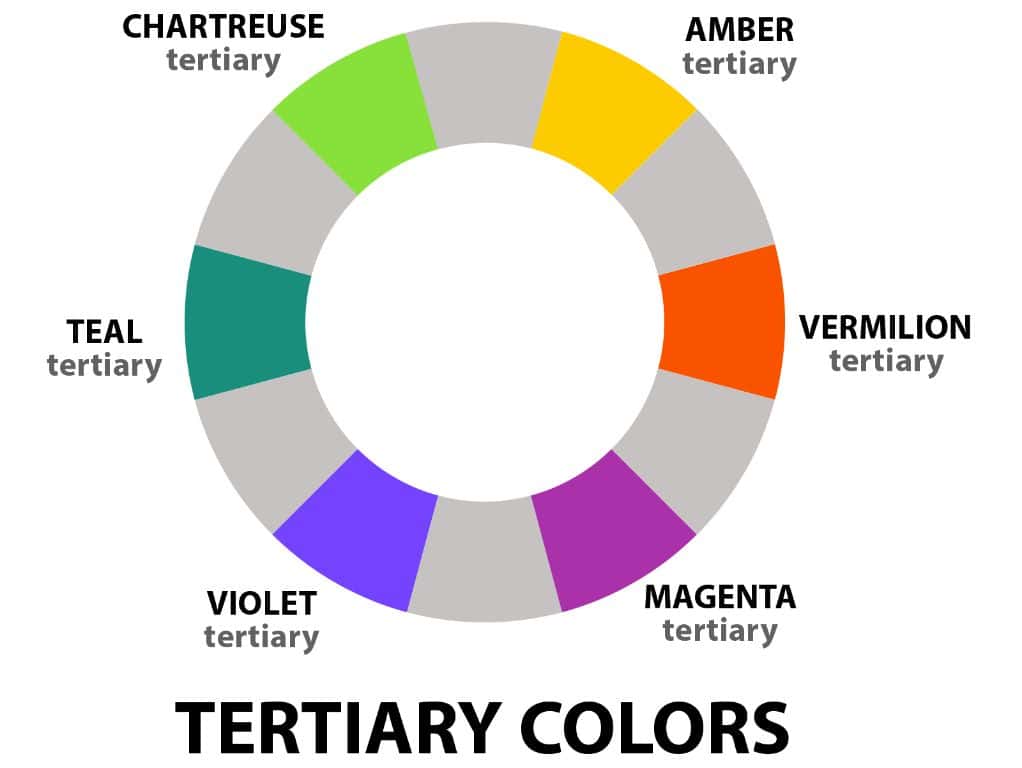Colour can be produced in several ways. The primary colours are red, blue and yellow. When two primary colours are combined, they produce secondary colours – green, purple and orange. When all three primary colours are combined, they produce black (the absence of light). When no colours are combined, the result is white (the presence of all light).
Beyond the primary and secondary colours are the tertiary colours. A tertiary colour is made by combining a primary colour with an adjacent secondary colour. For example, red and orange combine to make red-orange. Blue and green combine to make blue-green. Yellow and green combine to make yellow-green.
How Tertiary Colours Are Formed
There are 6 tertiary colours, formed by the following combinations of primary and secondary colours:
– Red-orange: Red + Orange
– Yellow-orange: Yellow + Orange
– Yellow-green: Yellow + Green
– Blue-green: Blue + Green
– Blue-purple: Blue + Purple
– Red-purple: Red + Purple
The tertiary colours fill in the gaps between the primary and secondary colours on the colour wheel. They are made by blending adjacent colours in equal parts.
For example, to make red-orange, you would combine equal parts red and orange paint. The resulting colour would be halfway between a pure red and a pure orange.
Light vs. Paint
It’s important to understand that mixing colour pigments (like paint) is different than mixing coloured light (like on a computer screen).
When mixing paints, the colours subtract from each other, eventually turning to brown or black if too many are combined. But when mixing light, the colours add to each other, eventually turning to white if they are all combined.
So tertiary colours can be created with both light and pigments, but the principles for mixing them are different. On a computer screen, red light and orange light combine to make red-orange light. But in paint, red pigment and orange pigment combine to make a darker, duller red-orange.
| Mixing Method | Primary Colours | Secondary Colours | Tertiary Colours |
|---|---|---|---|
| Light | Red, Green, Blue | Cyan, Magenta, Yellow | Red-orange, Blue-green, etc. |
| Paint | Red, Yellow, Blue | Orange, Green, Purple | Red-orange, Blue-green, etc. |
This table summarizes the different primary, secondary, and tertiary colours that result from mixing light vs. mixing paints.
The Colour Wheel
The relationships between primary, secondary, and tertiary colours can be visualized on a colour wheel:

|
The primary colours are equally spaced around the wheel at 0°, 120°, and 240°. The secondary colours fall halfway in between, at 60°, 180°, and 300°. Finally, the tertiary colours fill in the gaps between adjacent primary and secondary colours.
This colour wheel shows how the tertiary colours are blendings of a primary and secondary colour. For example, yellow-orange (60°) sits between the primary yellow (60°) and the secondary orange (30°).
Uses of Tertiary Colours
Tertiary colours have many practical applications:
– In painting, tertiary colours are useful for blending and shading. They create subtle variations between the vivid primary and secondary colours.
– On computer displays, the red, green, and blue pixels can be combined to create a full spectrum of tertiary colours. This makes digital colour very versatile.
– In fashion and interior design, tertiary colours like burgundy, teal, and lime green are commonly used accent colours. They liven up and complement the main colour scheme.
– Tertiary colours are also important in nature. Many plants and animals have tertiary-coloured features, like orange-red flowers or blue-green eyes.
Colour Harmony
When choosing tertiary colours for design, it helps to understand colour harmony principles:
– Analogous colours are neighbouring hues like yellow-green and yellow-orange. Using analogous tertiary colours creates a vibrant look.
– Complementary colours are opposite each other on the wheel, like red-orange and blue-green. They create high contrast when paired together.
– Split complementary colours use a colour and the two on either side of its complement, like red-orange with blue-green and blue-purple. This provides a subtle, sophisticated effect.
Following these kinds of harmonious colour combinations ensures tertiary colours work together effectively.
Conclusion
Tertiary colours fill the gaps between the primary and secondary colours. They are made by mixing equal parts of adjacent colours on the colour wheel. Understanding how to create tertiary colours with light vs. pigment is important. Tertiary colours have many uses in art, design, nature, and digital displays. Following principles of colour harmony allows them to be used in aesthetically pleasing ways.


